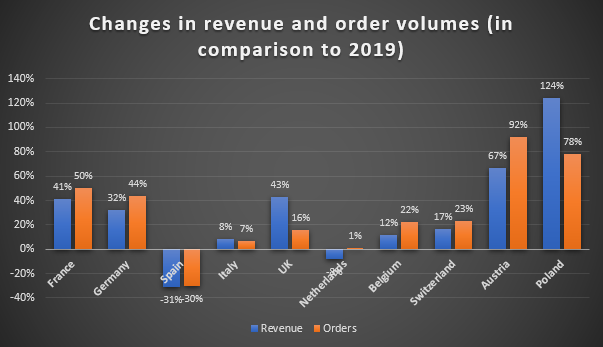Europe’s E-commerce Market is rapidly changing under the coronavirus crisis
In the last month, Europe has seen its coronavirus cases soar. There are now almost half a million cases in Europe alone, with Italy, Spain, France, Germany and the UK the worst affected. As the severity of the situation has grown, governments have had to enforce strict rules such as social distancing and this has resulted in businesses closing and many citizens staying at home across Europe.
Although this is not been good news for physical retail stores, online retail has a different story to tell. E-commerce across Europe is changing at a lightning-fast speed under the coronavirus crisis, and for many online stores this has meant growing sales, traffic and customers. Certain types of products are also now stealing the spotlight from product categories that were the most popular previously.
In the coming weeks, we will highlight the key trends that are taking place across Europe as a result of the coronavirus and their overall impact on European E-commerce.
In this article (Part 1), we will focus on how E-commerce as a whole has grown across Europe in recent weeks.
E-commerce revenue and order numbers have increased for the majority of European countries
With more residents staying at home and fewer physical stores open for business, there has been a noticeable shift in buyer behaviour in recent weeks. This has resulted in an increase in online orders and the overall revenue generated in E-commerce, and this is most obvious particularly across Poland, Austria, the UK, France and Germany.
A study conducted by Emarsys into 2,500 online brands has demonstrated these changes across Europe. The following figures demonstrate how the performance of revenue and orders within each country during 26 March – 2 April 2020 compare with the same period a year ago (26 March – 2 April 2019).

The chart demonstrates that there has been an overall increase in revenue and orders for most of the countries listed, with a particularly noticeable rise in Eastern European countries (Austria and Poland).
Why are some European countries ordering online more than others?
Looking at the graph, it is clear the current E-commerce situation in Spain differs from the numbers presented by countries such as France, Germany and the UK. It could be reasoned that this is down to the fact that Spain has one of the lowest E-commerce penetration rates in Europe with online shopping making up about 4-5% of Spain’s overall retail revenue.
There is also a clear link between which countries frequently shop for groceries online in general and which countries have increased their consumption of online goods during the coronavirus pandemic. In general Spanish consumers prefer to purchase groceries from outdoor markets rather than online stores, and online grocery shopping only had a market penetration of 3% in 2019, in comparison with France’s 7% and the UK’s 8%. This could explain why there has been less revenue generated in Spain in comparison to other countries.
However, there is some evidence that countries such as Spain could be making the transition to becoming more active in E-commerce as a response to the coronavirus crisis – this will be explained later on in another issue of “Coronavirus and its impact on E-commerce in Europe”.
Stay tuned for part 2, where we will focus on the products that are gaining popularity in Europe due to the coronavirus.
